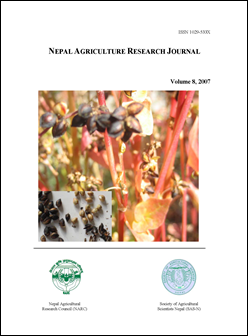Measuring Returns from Improved Rice, Maize and Wheat Research in Nepal
DOI:
https://doi.org/10.3126/narj.v8i0.11602Keywords:
Agriculture, Food crops, Impact, Internal rate of return, Livelihood, Research investmentAbstract
Studies on returns to research have been established in different countries to justify research funding and allocation of research priorities. However in Nepal, there are no scientific studies carried out recently on return to research investment in major crops and commodities, despite priority given in agricultural sector. This paper has summarized the research investment with respect to major cereals viz; rice, maize, and wheat and income generated by the impact of improved varieties of these crops in Nepal. Internal rate of return for major cereal crops (rice, maize, and wheat) was estimated using time series data of 1995 to 2005. The findings revealed that there is a negative annual growth rate (-0.59%) of NARC budget during 1998-2004. There was a food deficit during mid nineties, however, in the late nineties while despite tremendous curtailing of budget for research, a surplus of food grain was observed. Although the situation of positive food grain balance is not the result of current year's efforts on research it could be the impacts of years of efforts that were in a continuous pace in the past for agriculture R&D coupled with the impacts of extension related activities in the country. Food surplus is mainly contributed by the efforts of massive release of improved varieties of crops by NARC during late nineties. The internal rate of return (IRR) of these cereals for a decade (1995-2004) was in the range of 84-105%, which is around Rs 235673 millions of income generation while investment for their research was Rs 559 millions (0.24% of their revenue). This indicates that there is gross under funding on research for major crops, despite their significant contribution in national economy, food security, and livelihood improvement in Nepal. Finally paper suggests for increased investment in agricultural research for meeting increasing needs of food, income, and employment of growing population as well as enhancing and sustaining future agricultural R&D in the country.
Nepal Agric. Res. J. Vol. 8, 2007, pp. 103-112
Downloads
Downloads
Published
How to Cite
Issue
Section
License
This license allows reusers to copy and distribute the material in any medium or format in unadapted form only, for noncommercial purposes only, and only so long as attribution is given to the creator.




